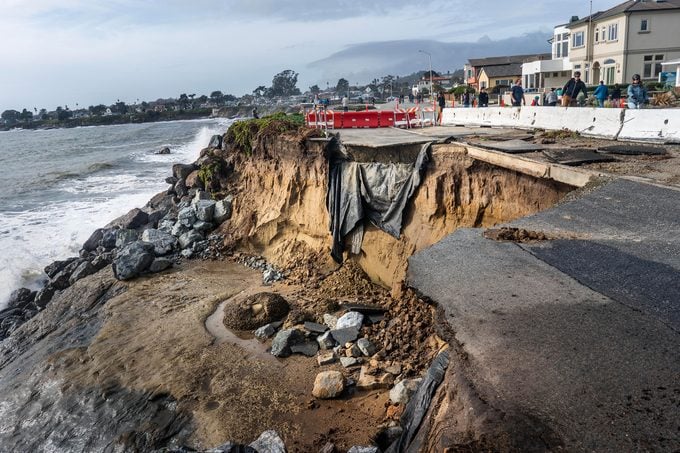What Is a Bomb Cyclone?
Updated: Jan. 11, 2023

Here's what you need to know about the powerful storm ripping across America
If you live in the United States or Canada, chances are you’ve heard the term “bomb cyclone” thrown around in the last few days. This winter storm also goes by the less-common names “bombogenesis” or “explosive cyclogenesis.” While this weather phenomenon is common enough, this particular event has received attention for its rapid increase in strength, leading to casualties, power grid failures, flight cancellations, and shipping delays throughout the U.S. and Canada.
What Is a Bomb Cyclone?
In the words of UCLA climate scientist Daniel Swain, “a ‘bomb cyclone’ refers directly to the rate of [the storm’s] strengthening, not necessarily to its absolute strength.” In order to qualify, the air pressure of the low-pressure cold mass must drop at least 24 millibars in 24 hours.
For reference, a regular cyclone is caused when low-pressure cold air meets high-pressure warm air. The rapid impact of these two air masses paired with the natural rotation of the earth yields swirling winds.
The current bomb cyclone qualified in late December when the air pressure over the Great Lakes dropped to at least 962 millibars, while it remained as high as 1047 millibars elsewhere.
What Are the Effects of a Bomb Cyclone?

Bomb cyclones typically result in intense cold fronts, high-velocity winds and heavy rain or snow. However, different areas can expect to experience different combinations of these weather patterns. In December, the bomb cyclone resulted in blizzard-like conditions in the Midwest, Great Plains, South and Northeast with over 183 million Americans on wind chill advisories. The bomb cyclone brought an uncharacteristic pile of snow to the Pacific Northwest over Christmas, and despite initial predictions, California is now bearing the brunt of the impact.
Northern California is currently being hit the hardest, with San Francisco experiencing its heaviest 10-day rainfall since 1871, Point Reyes’ waves reaching staggering heights of up to 60 feet and the Bay Area experiencing up to 100 mph winds.
But Central and Southern California are by no means out of the woods. Governor Gavin Newsom has declared a state-wide state of emergency and his office warns that “[r]esidual flooding impacts could extend into the weekend along with additional storms lingering into next week.”
Is a Bomb Cyclone the Same as a Hurricane?
The effects of the bomb cyclone (and the coinciding atmospheric river) in California may remind some of a hurricane. However, while the effects are similar—strong winds, heavy rainfall and surge flooding—their causes are still different. As Stain points out, “Hurricanes derive their energy from warm tropical oceans, whereas ‘mid-latitude cyclones’ (like the present one) derive their energy from horizontal temperature differences in the atmosphere.'”
Precautions You Can Take
While most of America is now through the worst of the bomb cyclone, if you’re in California, there are definitely some preparations to consider for the coming week. First, avoid any non-essential travel. If you must drive, follow up-to-date road info through CalTrans; steer clear of central Highway 1, parts of which have been washed away; and avoid bridges over fast-moving water. Remember that only a foot of water is enough to sweep your vehicle away!
Additionally, purchase or assembly a power outage emergency kit including batteries, alternative power sources and flashlights. Lastly, if you are under a flood warning, find shelter and never walk or swim through flood waters—even six inches can knock you down. Stay safe and dry out there!
Sources:
- SkyNews: US Bomb Cyclone: At least 59 dead as North America gripped by devastating winter storm
- The New York Times: What Is a Bomb Cyclone?
- KLTA: What Exactly Is a Bomb Cyclone?
- TIME: At Least 15 Deaths Attributed to the Bomb Cyclone: Here’s What We Know
- LA Times: Most of the U.S. Is Facing a Bomb Cyclone: Here’s Why California Will Be Spared
- CNN: The cyclone that killed a child in California is battering the state with ferocious winds, mudslides and even more flooding
- The Guardian: Two dead as ‘bomb cyclone’ brings heavy winds and rain to California
- NPR: Powerful storm slams into California, bringing power outages and fears of flooding
- Office of Governor Gavin Newson: Governor Newsom Proclaims State of Emergency and Mobilizes State Government Ahead of Winter Storms
- NOAA: What Are Atmospheric Rivers?
- FoxWeather: Deadly bomb cyclone washes away popular California beach



















